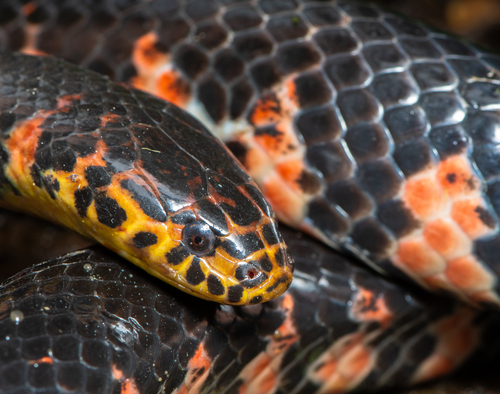
Red-bellied Mudsnake
The Red-bellied Mudsnake, with its glossy black and vibrant red underside, slithers through southeastern U.S. wetlands. A stealthy predator, it uniquely subdues prey using its tail. This non-venomous snake is crucial for maintaining ecological balance, showcasing nature's intricate interdependencies.
19 years
Lifespan
Length: 36 - 122 cm
Size
Brown, Grey, Red, Multi-colored
Color
Low
Aggression
Least Concern
Conservation Status
Stable
Population Trend
Characteristics
Farancia abacura, commonly known as the Red-bellied Mudsnake, is a non-venomous snake native to the southeastern United States. It thrives in wetland habitats, often found near slow-moving streams, marshes, and swamps. This species is known for its glossy black back and striking red belly. It has a unique feeding behavior, primarily preying on eels and amphibians, and employs a distinctive tail-coiling technique to subdue its prey. The mudsnake plays a vital role in controlling amphibian populations in its ecosystem.
Distribution Range of the Red-bellied Mudsnake
The Farancia abacura, commonly known as the Eastern Mudsnake, is native to the southeastern United States. Its geographical distribution extends across the coastal plain from eastern Texas and southern Arkansas to southeastern Virginia, including the states of Louisiana, Mississippi, Alabama, Georgia, Florida, South Carolina, and North Carolina.
Red-bellied Mudsnake's Habitat
Environmental Conditions
Eastern Mudsnakes are typically found in aquatic environments such as swamps, marshes, and slow-moving streams and rivers. These habitats are characterized by warm, humid climates with abundant water and dense vegetation.
Ecological Niche
The species has a specialized ecological niche, primarily preying on aquatic amphibians like sirens and amphiumas. It is adapted to a semi-aquatic lifestyle, spending much of its time in or near water bodies, where it utilizes its smooth, shiny scales to move gracefully through the water.
Copyright @ Nature Style Limited. All Rights Reserved.
 English
English